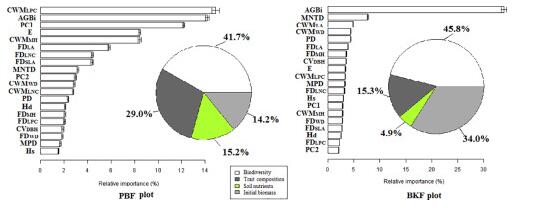Determining the main drivers of coarse woody productivity in temperate mixed forests
As the main part of terrestrial biosphere, forest ecosystems play an important role for the global regulation of carbon, a substantial portion of which is maintained in above-ground biomass. Yet, it is still poorly understood what factors are driving forest aboveground biomass productivity. While it is well understood forest productivity may be simultaneously driven by different abiotic factors (i.e. soil nutrients) and biotic factors (i.e. the diversity, trait composition and initial stand biomass) at local scale, the relative strengths of these drivers have not been investigated in temperate forests.
Since these factors having multicollinearity and may exist linear or non-linear relationships with productivity, it is difficult to distinguish and evaluate the sole role of each predictor. Four potential mechanisms, the niche complementarity hypothesis, the mass ratio hypothesis, soil fertility hypothesis and green soup hypothesis are proposed to maintain ecosystem productivity. However, it is unclear how the relative importanceof each mechanism changes with forest succession.
Base on the ten years forest monitoring data in Changbai Mountain, Associate Prof YUAN Zuoqiang from the research group of Natural Forest Ecology, IAE and his cooperators evaluated the relative contribution of multiple metrics of tree diversity (taxonomic, functional and phylogenetic diversity and trait composition as well as stand structure attributes), stand initial biomass and soil nutrients on productivity using boosted regression tree (BRT) model.
Their results showed that community-weighted mean of leaf phosphorus content, initial stand biomass and soil nutrients were the three most important individual predictors for CWP in secondary forest. Instead, initial stand biomass, rather than diversity and functional trait composition (vegetation quality) was the most parsimonious predictor of CWP in old growth forest.
They suggested that vegetation quantity, rather than diversity and soil nutrients, is the main driver of forest productivity in temperate mixed forest.The effect of diversity for productivity in natural forests may not be so important as often suggested, at least not during the later stage of forest succession.
The findings are in accordance with the idea that subtle effects of community functional properties on productivity might be over-ridded by steep biomass buildup over succession.
Future studies on biodiversity and ecosystem functioning should unravel the influences of vegetation quality (i.e. functional diversity and community-weighted mean of a trait values) from those of vegetation quantity (i.e. initial standing biomass) and/or abiotic factors (i.e. soil nutrients) on ecosystem processes, functions and services.
The results were published in Science of The Total Environment entitled as Abiotic and biotic determinants of coarse woody productivity in temperate mixed forests.
The work was supported by National Key R & D Project, NNSFC and Youth Innovation Promotion Association of the Chinese Academy of Sciences.

Fig. 1 Relative importance of different predictors on coarse woody productivity (CWP) in secondary (PBF plot) and old growth forest (BKF plot) using the boosted regression tree analysis Pie charts show the summed relative influences of biodiversity indices, trait composition, soil nutrients, stand structure, initial stand biomass and first two principal component axes (PC) of soil nutrients variables (Image by YUAN Zuoqiang).
Email: yueqian@iae.ac.cn
Publication Name:YUAN Zuoqiang et al.



